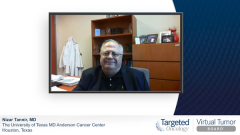
Rationale for Lenvatinib plus Pembrolizumab Therapy in Frontline Setting in Advanced Clear Cell RCC
Dr Moshe Ornstein shares his take on the survival, efficacy, and toxicity data of the CLEAR trial in advanced clear cell RCC.
Episodes in this series

Nizar Tannir, MD: Thank you, Scott, for sharing with us the data from the CLEAR study. I wanted to take this opportunity to ask Moshe [a question]. Moshe, you’re familiar with the data, and you saw the data on the slides that Scott presented. In your mind, what’s the rationale of combining lenvatinib with pembrolizumab? Is this impressive? The CR [complete response] rate was 16%, OR [overall response] was 71%, median PFS [progression-free survival] was 23.9 months, with a PFS hazard ratio of 0.39 and the OS [overall survival] benefit. Is that because lenvatinib is a potent VEGFR TKI [tyrosine kinase inhibitor]? Or do you think the fact that it also inhibits BFGF plays a role and produces these impressive results? What’s your take on that?
Moshe Ornstein, MD, MA: That was a great overview of the data. In some ways, we’re working backward. Of all the I/O [immuno-oncology]–TKIs that have been approved, the CLEAR trial with lenvatinib and pembrolizumab was the last piece of the puzzle. That said, despite it being the last piece of the puzzle, it sets the bar and the new benchmark for what we’d need to see to change the standard of care for treatment-naïve metastatic clear cell RCC [renal cell carcinoma].
Getting to your question as to why those results were so impressive, I’m not convinced that any single TKI is necessarily better or stronger based on the specific targets. Because they’re all VEGFR inhibitors, more important perhaps than the individual targets is the dosing. For the population at large, there’s the concept of linear pharmacokinetics when it comes to VEGFR TKIs, such that collectively, a higher dose is generally equated with a higher plasma level and a better response. That said, there are some patients with very high doses whose cancers don’t respond, and some patients on very low doses who have exceptional anti-tumor responses.
The No. 1 reason why the efficacy in this regimen was so impressive—with the I/O–TKIs we’re looking at that up-front benefit of response rates and PFS—is because they started at a high dose of lenvatinib at 20 mg and, as we’ll see when we review the other I/O–TKI regimens, there were different doses for the TKI. If you were to ask many kidney cancer specialists 3 or 4 years ago what data they would need to see from an I/O–TKI regimen to have it set as a new benchmark, with numbers like a response rate of 70%-plus, a PFS of close to 2 years, and complete response rates of 16%, most would have said that numbers like that would at least make this combination extremely competitive in the growing landscape, if not set it apart as the optimal choice for the patient who can tolerate the toxicities and that dose of TKI.
I’ll summarize by saying that these data are extremely impressive. They set a new benchmark for efficacy in the response rate, CR rate, and PFS components. I also think it’s related more to the dosing than it is to lenvatinib’s different targets compared with some of the other TKIs.
Transcript edited for clarity.











































